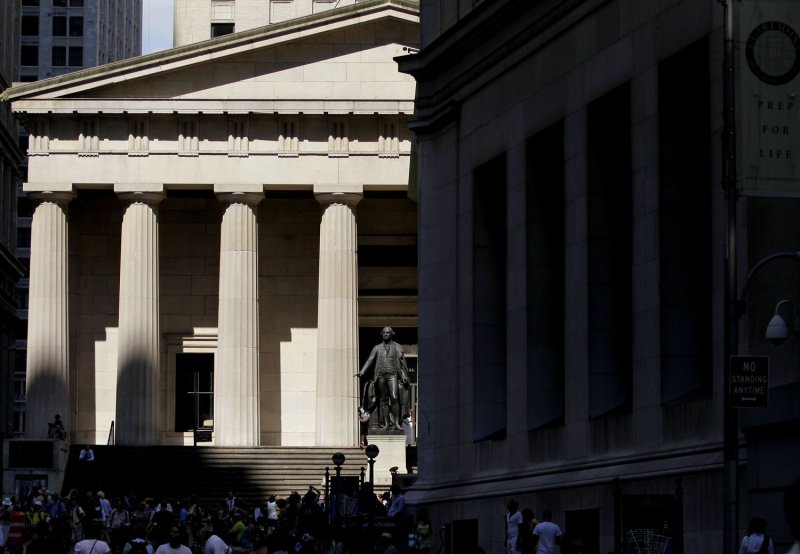People gather around a statue of the first United States President, George Washington, in front of Federal Hall National Memorial by the New York Stock Exchange before the closing bell on Wall Street In New York City on August 17, 2011. UPI/John Angelillo |
License Photo
PARIS, Aug. 22 (UPI) -- The surprise is that rational people in business and the markets have been so surprised by the double-dip recession. A renewal of the financial crisis was a pretty logical development once the fiscal ammunition ran out.
From 2008 through the end of 2010, governments and central banks around the world spent more than $10 trillion in stimulus funds, deficit spending and the creation of liquidity. For that tsunami of money (and debt) we got a very anemic recovery in the developed markets of the United States, Europe and Japan and a probably unsustainable boom in emergent markets, particularly China.
Their boom looks unsustainable because their big export markets in the developed economies were unable to maintain their previous trend in import growth. China has had some success in shifting consumption to its own (potentially vast) internal market but not enough to maintain its double-digit growth rates.
So the money has run out, along with the political will to go further into debt. Government spending is set to fall in the United States and in most of Europe and private consumers are in poor shape to take up the slack.
The double-dip recession therefore looms. It has been made more likely by the way the animal spirits of investors have been lowered by the sense of political deadlock and impotence in Washington and by incompetence in Europe which continues to dither with the eurozone's debt crisis.
There are four long-term trends that will keep many investors depressed.
The first is that energy prices will remain high because the market is no longer functioning as it should. Governments have intervened to a distorting extent. The most obvious example is Saudi Arabia, where the government's $160 billion boost in various forms of welfare spending (an insurance against a Saudi version of the Arab Spring unrest) means that the Saudi government budget requires an oil price of $88 a barrel or more.
The second long-term trend is that the era of cheap food is probably over. Later this year the 7 billionth person will be born somewhere on the planet. By 2050, there will almost certainly be more than 9 billion. That is a lot of extra mouths to feed. And it isn't at all clear where the arable land and the water will come from to feed them.
In the short term, food prices will rise because people in China and India and other emerging markets are eating more meat. In consequence arable land that could be producing basic grains for humans is producing animal feed. As people climb the prosperity ladder they also climb the protein ladder and prices accordingly rise.
The third long-term trend is that China's growth is slowing. This is partly by design, as the government tries to dampen inflation and limit the environmental damage caused by breakneck growth. And it is partly by the usual economic forces as Chinese workers demand more pay and investors look for lower-wage economies elsewhere like Vietnam and Bangladesh. China's demographic future, warped and distorted by 30 years of the one-child policy, suggests a more profound long-term brake on China's prospects.
Energy prices, food prices and a slowing China make for a sobering combination as we try to look ahead at the prospects for the world economy for the rest of this decade.
But the fourth trend is the one that should really depress pension funds and insurance companies and all investors looking for the longer term after the year 2020. That is when the huge challenge of paying for the health and pensions of a much larger proportion of older people really starts to become acute.
Of course this can be alleviated by increasing the retirement age (if there are jobs available) and with luck with some improvements in medical technology and health management.
But the first will require political will, which seems in short supply in governments these days and a readiness to take on the vast cohort of the elderly who punch much above their weight in political terms because they are much more likely to vote. The second is uncertain and will certainly require more short-term investment.
And, of course, this will impose further strains on government finances and almost certainly higher taxes. This isn't just a problem for the developed world and for fast-aging Europe and Japan in particular. It is also a very serious challenge for China and for all the other emerging markets where growing prosperity will mean greater longevity.
So does this mean that the era of global economic growth is over? Not at all. On a conservative estimate, the rapid advance in emergent market prosperity suggests that over the next 10 years global income per capita is likely to almost double from $8,000 a head today to more than $15,000 in 2020.
This won't be evenly spread among income groups (so luxury goods will do well) and rising food and energy prices will eat up a lot of that extra income. But this new growth will be much more evenly distributed by geography, which is why corporations and investors have been pumping money into emergent markets.
Some of that money will be lost in local financial and political crises, more will be wasted on unproductive investments and unpredictable amounts will be siphoned off through corruption and various disguised forms of local protectionism. But on the whole, the markets are investing rationally in the most likely vectors for global growth of the future, rather than in stagnant Europe and America. As a result, flat growth in the Group of Seven economies starts to look like a self-fulfilling prophecy.















